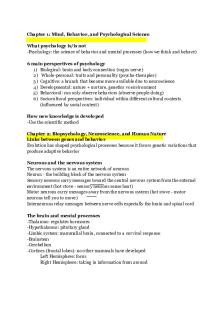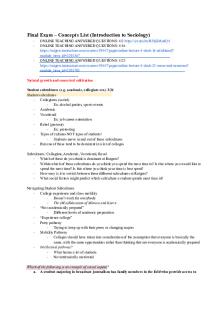Microscope Intro Study Guide PDF

| Title | Microscope Intro Study Guide |
|---|---|
| Course | Fundamentals Of Microbiology Laboratory |
| Institution | East Carolina University |
| Pages | 2 |
| File Size | 69.5 KB |
| File Type | |
| Total Downloads | 16 |
| Total Views | 134 |
Summary
Microscope Study Guide...
Description
Microscope Intro Study Guide 1. _______ use light rays passing through lenses to magnify the object. : light microscopes 2. A stereomicroscope is also called a(n) _______. : dissecting scope 3. _______ are designed to study entire objects in 3D at low magnification. : stereomicroscopes (dissecting scope) 4. A _______ is used for examining small or thinly sliced sections of objects under higher magnification. : compound light microscope 5. Compound refers to the use of two sets of lenses called, _______. : ocular and objective 6. Illumination in a compound light microscope comes from _______ the specimen. : below 7. Only clean lenses with _______. : lens paper 8. T/F It is not important to clean oil from the immersion lens are using it. : F 9. To avoid spreading oil to other objects, start with _______ objectives then clean the _______ lens. : lower, 100x 10. The _______ is also known as ocular lenses. : eyepiece 11. The _______ holds ocular lenses. : viewing head 12. The _______ supports the upper parts of the microscope and is used to carry. : arm 13. The _______ is a revolving piece that contains the objectives. : nosepiece 14. The _______ objective is the lowest used to scan the whole slide. : scanning (4x) 15. The _______ objective lens is longer than the scanning and is used for even greater detail. : low power (10x) 16. The _______ objective lens is longer than the low power and has greater detail. : high power objective (40x) 17. The _______ objective lens is used with immersion oil for greatest magnification. : oil immersion objective (100x) 18. The _______ is the platform that holds the slide. : stage 19. The _______ hold the slide in place. : stage clips 20. The _______ are used to move the stage/object forward/back and left/right. : mechanical stage knobs 21. The _______ is used for initial focus with the lowest power objective. : coarse adjustment knob 22. The _______ is used for final focus. : fine adjustment knob 23. The _______ is the lens system below the stage used to focus the beam of light. : condenser 24. The _______ is the lever that controls the amt of light passing through condenser. : diaphragm 25. The _______ is the attached lamp that directs light up through the object/specimen. : light source 26. The _______ is the flat surface the microscope rests on. : base 27. By moving the diaphragm to the right, you will notice more _______, less _______, and greater _______. : contrast, intensity, depth of field 28. Moving the light source intensity away from you _______ intensity. : reduces 29. The field of view on a microscope is the circle that is visible through the _______ lens. : ocular 30. Most compound light microscopes have _______ objectives mounted on the nosepiece directly over the stage. : 3 to 4 31. The longer the lens the greater the _______. : magnification 32. Magnification is limited by _______. : resolution
33. _______ is the ability to see two objects as separate and distinct. : resolution 34. Resolution depends on _______ of light. : refraction (scattering) 35. Refraction can be limited by _______ and _______ of lens. : short wavelengths, numerical aperture 36. Shorter wavelengths = _______. : better resolution 37. Most scopes employ a _______ which have short wavelengths. blue filter 38. The _______ is the ability of the objective to capture scattered light. : numerical aperture 39. Numerical aperture is related to the _______ of the lens. : curvature 40. The total magnification is figured by taking the power of the _______ lens and multiplying it by the power of the _______ lens. : ocular, objective 41. As you increase magnification the field of view will get _______. : darker 42. T/F Glass and air have different refractive indexes. : T 43. Some light is _______ before it makes it to the objective. : lost 44. Glass and _______ have almost identical refractive indexes. : oil 45. If more light makes it to the objective lens, there is less _______ and better _______. : refraction, resolution 46. The use of oil immersion increases magnification approximately _______ fold. : 2.5 47. When using the oil immersion lens, move lens to _______, add a _______ drop of oil, move _______ back into place, and use the _______. : side, small, oil immersion lens, fine adjustment knob 48. When using the oil immersion lens you should be able to see a _______ between the lens and slide. : seal 49. Always begin focusing on the _______. : lowest possible power 50. To deal with your field of view becoming darker due to higher power, the iris diaphragm needs to be _______ to allow more light into the condenser. : opened 51. As you switch from low to high power the field of view becomes _______ in size. : smaller 52. List the bacterial shapes/cell morphologies. _______ : bacilli/bacillus, cocci/coccus, sprilla/spirochete...
Similar Free PDFs

Microscope Intro Study Guide
- 2 Pages

Intro study Guide 1
- 15 Pages

Intro to Biology Exam 2 study guide
- 11 Pages

Study Guide Intro to pub Speak
- 8 Pages

Intro to sociology ch 1 study guide
- 11 Pages

Intro to Stats Final Study Guide
- 15 Pages
Popular Institutions
- Tinajero National High School - Annex
- Politeknik Caltex Riau
- Yokohama City University
- SGT University
- University of Al-Qadisiyah
- Divine Word College of Vigan
- Techniek College Rotterdam
- Universidade de Santiago
- Universiti Teknologi MARA Cawangan Johor Kampus Pasir Gudang
- Poltekkes Kemenkes Yogyakarta
- Baguio City National High School
- Colegio san marcos
- preparatoria uno
- Centro de Bachillerato Tecnológico Industrial y de Servicios No. 107
- Dalian Maritime University
- Quang Trung Secondary School
- Colegio Tecnológico en Informática
- Corporación Regional de Educación Superior
- Grupo CEDVA
- Dar Al Uloom University
- Centro de Estudios Preuniversitarios de la Universidad Nacional de Ingeniería
- 上智大学
- Aakash International School, Nuna Majara
- San Felipe Neri Catholic School
- Kang Chiao International School - New Taipei City
- Misamis Occidental National High School
- Institución Educativa Escuela Normal Juan Ladrilleros
- Kolehiyo ng Pantukan
- Batanes State College
- Instituto Continental
- Sekolah Menengah Kejuruan Kesehatan Kaltara (Tarakan)
- Colegio de La Inmaculada Concepcion - Cebu









